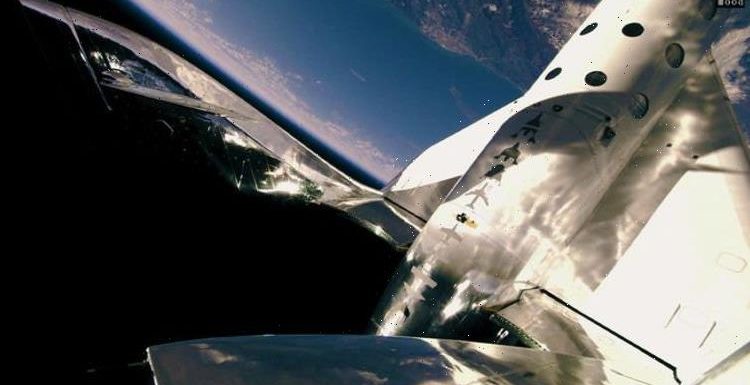
Virgin Galactic introduces the Unity 22 crew
We use your sign-up to provide content in ways you’ve consented to and to improve our understanding of you. This may include adverts from us and 3rd parties based on our understanding. You can unsubscribe at any time. More info
Spaceflight seems very simple at first glance: Point your rocket upwards and watch it clear the planet’s atmosphere till it hits the edge of space. But as Virgin Galactic is about to prove this weekend, what appears to be a simple concept on paper, can quickly become a very heated debated – especially if there is no international agreement over where the Earth ends and space begins.
Virgin Galactic will perform its fourth spaceflight this Sunday, July 11, with Virgin mogul Sir Richard Branson joining the crew.
The space tourism company aims to bring spaceflight to the masses – at least those who can afford the hefty price – and tomorrow’s flight marks the first of many crewed flights to come.
Virgin Galactic’s SpaceShipTwo spaceplane, VSS Unity, will blast off from Spaceport America in New Mexico, US, targetting a suborbital flight some 56 miles up.
The spaceplane will spend approximately four minutes in a weightless environment before coming back down to Earth.
And this is where problems arise because not everyone thinks Virgin Galactic is going to reach the edge of space.


What is the Karman line?
At the root of Virgin Galactic’s spaceflight conundrum is the lack of an internationally accepted border of space.
The vast majority of the world agrees the edge of space is at an altitude of about 62 miles (100km) – the so-called Karman line.
Named after Hungarian-American physicist Theodore von Karman, the line marks the point where aerodynamic forces give way to orbital ones.
In other words, it’s the point where the atmosphere can no longer support a spacecraft flying at suborbital speeds.
The European Space Agency (ESA), for instance, says: “The Karman line at 100 km altitude is a generally accepted point that represents the boundary between Earth and space, but weather, and space weather, will often take no heed of boundaries defined by humans.”
Notable exceptions include the US Air Force and NASA, which consider the border of space to be 50 miles (80km).

By these standards, anyone to fly above this level earns the right to be called an astronaut.
But even within NASA there is some disagreement, with the space agency’s Mission Control defining the edge of space at 76 miles (122km) up.
Historically, this was the point where the Space Shuttle engaged its orbital thrusters.
This is where things get a little murky for Virgin Galactic because although the company’s launches will clear the 50 miles (80km) line, they won’t fly above the Karman line.
For most people, this is a minor problem but it has caught the attention of embittered rivals, Blue Origin.
The space tourism company, which is due to launch its first crewed flight on July 20, will fly above the Karman line and was sure to let its customers know.


In a scathing marketing attack published on Twitter, the company founded by former Amazon CEO Jeff Bezos challenged Virgin Galactic’s spaceflight credentials.
Blue Origin tweeted: “From the beginning, New Shepard was designed to fly above the Karman line so none of our astronauts have an asterisk next to their name.
For 96 percent of the world’s population, space begins 100 km up at the internationally recognized Karman line.”
But at the end of the day, does any of this really matter?
According to NASA, traces of the Earth’s atmosphere extends up to 621 miles (1,000km) from Earth so whatever Blue Origin and Virgin Galactic do, they will never truly steer clear of it.
NASA said: “Very roughly, it starts about 100 kilometres above the Earth, but there is still part of the Earth’s atmosphere even at this altitude.
“The atmosphere just gets less and less dense, and at these altitudes, the ‘scale height’ is several hundred kilometres, so that means the continued decrease in the atmosphere slows down significantly.”
Ultimately, this may be a matter for international bodies like the UN to resolve but the US has been historically reluctant to discuss the topic of space’s border.
Whatever the case may be, both Virgin Galactic and Blue Origin are bound to provide their customers with an unforgettable experience.
Source: Read Full Article